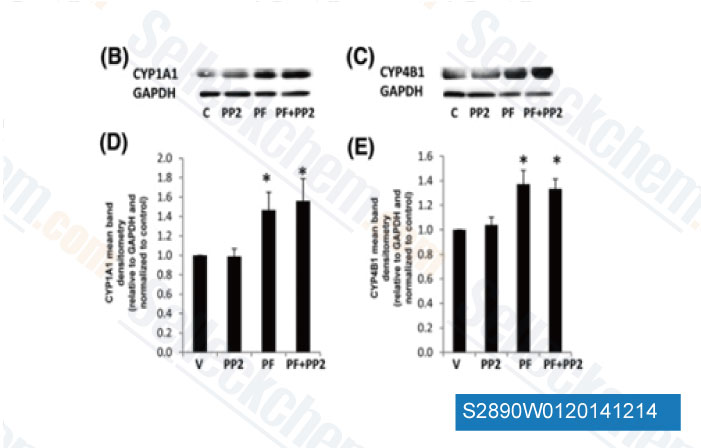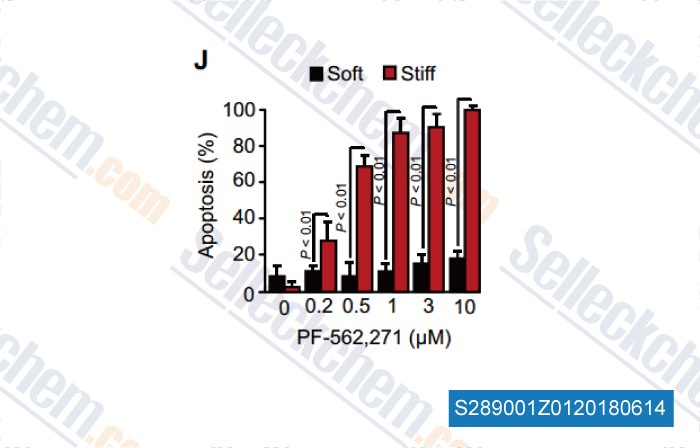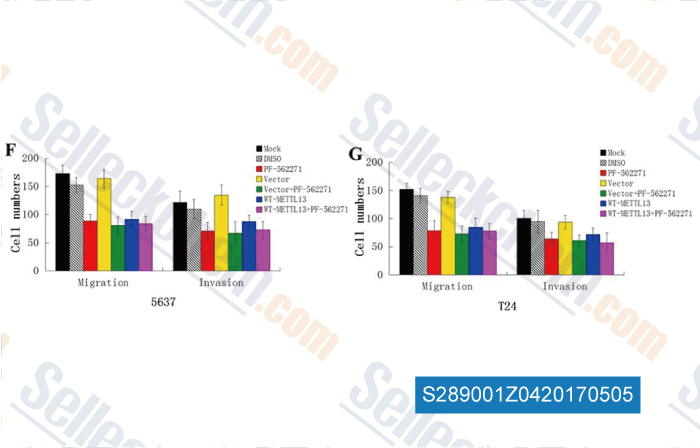|
How to Cite 1. For In-Text Citation (Materials & Methods): 2. For Key Resources Table: |
||
|
Toll Free: (877) 796-6397 -- USA and Canada only -- |
Fax: +1-832-582-8590 Orders: +1-832-582-8158 |
Tech Support: +1-832-582-8158 Ext:3 Please provide your Order Number in the email. We strive to reply to |
Technical Data
| Formula | C21H20F3N7O3S |
||||||||||
| Molecular Weight | 507.49 | CAS No. | 717907-75-0 | ||||||||
| Solubility (25°C)* | In vitro | DMSO | 100 mg/mL (197.04 mM) | ||||||||
| Water | Insoluble | ||||||||||
| Ethanol | Insoluble | ||||||||||
| In vivo (Add solvents to the product individually and in order) |
|
||||||||||
|
* <1 mg/ml means slightly soluble or insoluble. * Please note that Selleck tests the solubility of all compounds in-house, and the actual solubility may differ slightly from published values. This is normal and is due to slight batch-to-batch variations. * Room temperature shipping (Stability testing shows this product can be shipped without any cooling measures.) |
|||||||||||
Preparing Stock Solutions
Biological Activity
| Description | PF-562271 (PF-00562271) is a potent, ATP-competitive, reversible inhibitor of FAK with IC50 of 1.5 nM in cell-free assays, ~10-fold less potent for Pyk2 than FAK and >100-fold selectivity against other protein kinases, except for some CDKs. | |||||||||||
|---|---|---|---|---|---|---|---|---|---|---|---|---|
| Targets |
|
|||||||||||
| In vitro | PF-562271 binds in the ATP-binding cleft of FAK, forming two of the three “canonical” H-bonds between the inhibitor and main-chain atoms in the kinase hinge region. This compound is potent in an inducible cell-based assay measuring phospho-FAK with IC50 of 5 nM. It (3.3 µM) results in G1 arrest of PC3-M cells. [1] This chemical (1 nM) blocks bFGF-stimulated blood vessel angiogenesis as performed in chicken chorioallantoic membrane assays. It potently blocks blood vessel sprouting without detectable changes in vascular leakage. [2] It (250 nM) results in complete inhibition of collective A431 cell invasion into collagen gels. [3] |
|||||||||||
| In vivo | PF-562271 (< 33 mg/kg p.o.) inhibits FAK phosphorylation in tumors in a dose- and time-dependent manner in U87MG-bearing mice. This compound (50 mg/kg p.o. bid) results in 86% tumor growth inhibition in BxPc3 xenografts mice and 45% tumor growth inhibition in PC3-M xenografts mice. It (25 mg/kg, bid) results in 2-fold greater apoptosis in treated tumors in mice bearing H125 lung xenografts. [1] This chemical (33 mg/kg, p.o.) inhibits extensive movement of the tumor cells over 24 hours in mice. It (33 mg/kg, p.o.) results in altered E-cadherin dynamics in mice, which correlates with reduced E-cadherin–dependent collective cell movement. [3] This compound (25 mg/kg, p.o. bid) results in 62% tumor growth inhibition in PC3M-luc-C6 subcutaneuous local implant xenograft mouse model. [4] It (5 mg/kg, oral) results in significant and similar increases in osteocalcin and cancellous bone parameters and a decrease in tumor growth and signs of bone healing in rats implanted with MDA-MB-231 cells in the tibia. [5] |
Protocol (from reference)
| Kinase Assay: |
|
|---|---|
| Animal Study: |
|
References
|
Customer Product Validation

-
Data from [ Environ Toxicol Pharmacol , 2014 , 39(1), 114-124 ]

-
Data from [ PLoS One , 2014 , 9(2), e88587 ]

-
Data from [ , , Science, 2017, 9(420), doi: 10.1126/scitranslmed.aal3765 ]

-
Data from [ , , Sci Rep, 2016, 6:19261 ]
Selleck's PF-562271 (VS-6062) Has Been Cited by 132 Publications
| Chromosomal 3p loss and 8q gain drive vasculogenic mimicry via HIF-2α and VE-cadherin activation in uveal melanoma [ Cell Death Differ, 2025, 10.1038/s41418-025-01469-9] | PubMed: 40000790 |
| Evaluation of anti-liver cancer activity and anticancer mechanism of one novel small molecule compound (THY-10A62) targeting FAK pathway [ Front Oncol, 2025, 15:1498005] | PubMed: 40958869 |
| Cytoskeletal activation of NHE1 regulates mechanosensitive cell volume adaptation and proliferation [ Cell Rep, 2024, 43(12):114992] | PubMed: 39579355 |
| The E156K mutation in the CRYAA gene affects the epithelial-mesenchymal transition and migration of human lens epithelial cells [ Heliyon, 2024, 10(1):e23690] | PubMed: 38187316 |
| Integrin signaling is critical for myeloid-mediated support of T-cell acute lymphoblastic leukemia [ Nat Commun, 2023, 14(1):6270] | PubMed: 37805579 |
| Integrin signaling is critical for myeloid-mediated support of T-cell acute lymphoblastic leukemia [ Nat Commun, 2023, 14(1):6270] | PubMed: 37805579 |
| VE-Cadherin modulates β-catenin/TCF-4 to enhance Vasculogenic Mimicry [ Cell Death Dis, 2023, 14(2):135] | PubMed: 36797281 |
| VE-Cadherin modulates β-catenin/TCF-4 to enhance Vasculogenic Mimicry [ Cell Death Dis, 2023, 14(2):135] | PubMed: 36797281 |
| Architecture of androgen receptor pathways amplifying glucagon-like peptide-1 insulinotropic action in male pancreatic β cells [ Cell Rep, 2023, 42(5):112529] | PubMed: 37200193 |
| Combination of FAK inhibitor and cytokine-induced killer cell therapy: An alternative therapeutic strategy for patients with triple-negative breast cancer [ Biomed Pharmacother, 2023, 163:114732] | PubMed: 37254289 |
RETURN POLICY
Selleck Chemical’s Unconditional Return Policy ensures a smooth online shopping experience for our customers. If you are in any way unsatisfied with your purchase, you may return any item(s) within 7 days of receiving it. In the event of product quality issues, either protocol related or product related problems, you may return any item(s) within 365 days from the original purchase date. Please follow the instructions below when returning products.
SHIPPING AND STORAGE
Selleck products are transported at room temperature. If you receive the product at room temperature, please rest assured, the Selleck Quality Inspection Department has conducted experiments to verify that the normal temperature placement of one month will not affect the biological activity of powder products. After collecting, please store the product according to the requirements described in the datasheet. Most Selleck products are stable under the recommended conditions.
NOT FOR HUMAN, VETERINARY DIAGNOSTIC OR THERAPEUTIC USE.
